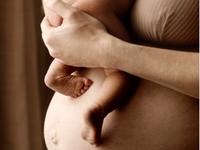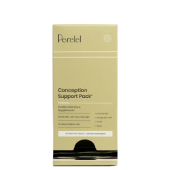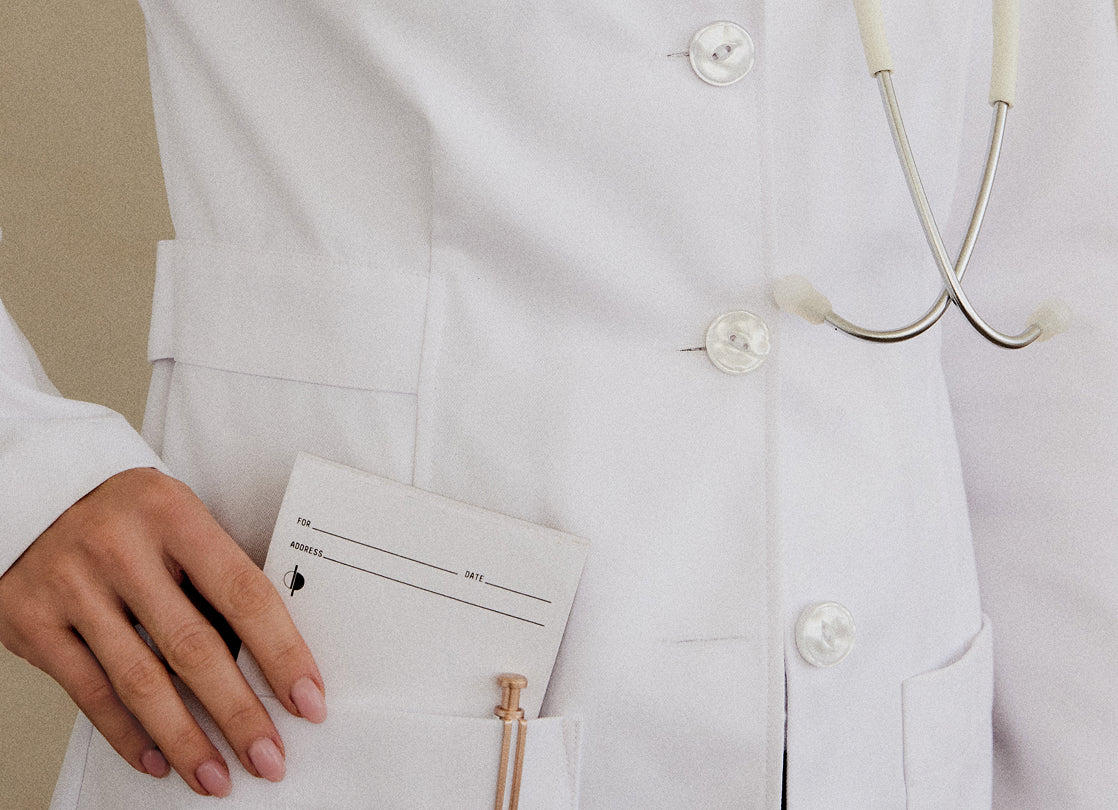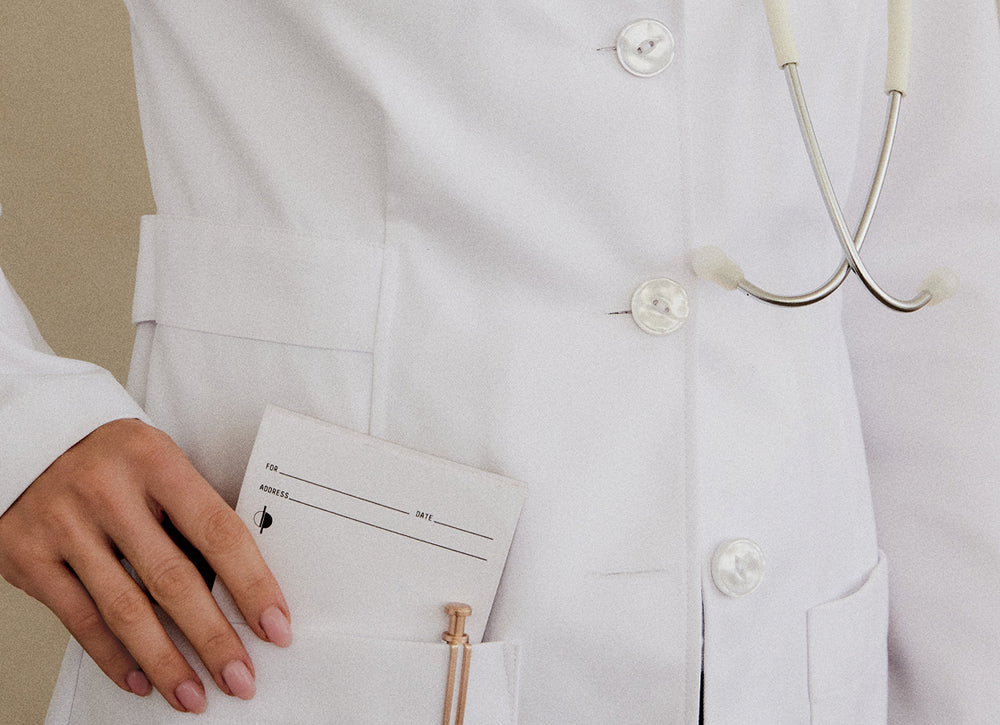Few things in life are as thrilling as a positive pregnancy test. But if pregnancy is uncharted territory, it can also be a bit scary. All the unknowns just might send you down a Google rabbit hole so deep, you’ll be celebrating your baby’s first birthday before you find all the answers you’re looking for. While we always encourage you to forge a close relationship with your healthcare provider, we also know that it's helpful to digest new information on our own terms. In that spirit, we created an overview of what to expect during pregnancy—from the symptoms of each trimester to the milestones taking place inside your body, and much more.
Early Pregnancy Symptoms
Pregnancy vs. PMS
If you’re trying to conceive, you know just how long the days can feel until your period is due. And you know just how hypersensitive you are to any symptoms that might indicate pregnancy. Unfortunately, the symptoms of early pregnancy and an impending period can be very similar. Mood swings, cramping, backaches, breast tenderness, headaches, food cravings—these symptoms are common in both PMS and early pregnancy.
While the only real way to confirm that you’re pregnant is a missed menstrual cycle and a positive pregnancy test, there are a few symptoms that are more often related to pregnancy. They include implantation bleeding and nausea and vomiting.
Six to 12 days after fertilization, the fertilized egg will attach to your uterine lining in a process called implantation. When this happens, some women will notice light spotting for one to three days. This spotting typically occurs around the time your period is due, but is usually much lighter and in volume and in color than a typical period.
If you don’t typically experience nausea right around the time you expect your period and you suddenly do, that can be another indication that you might be pregnant. Morning sickness, as it is so inaccurately called, can strike very early on in pregnancy.
Even before a positive pregnancy test confirms it, there are some telltale signs that you may be expecting. If you’re of childbearing age and have a consistent menstrual cycle, a missed period is one of the most classic early signs. But it’s not the only one. Here are some other signs and symptoms of early pregnancy:1,2
Tender, Swollen Breasts
Chalk this one up to all the hormonal changes that start very soon after conception. The good news is that the sensitivity and soreness you may be experiencing will likely subside as your body adjusts to the shift. Your breast size, however, may continue to grow as your pregnancy progresses—your mammary glands will enlarge in preparation for breastfeeding. You may also notice that the veins in your breasts become more visible and your areolas, the pigmented areas surrounding your nipples, growing in size.
Nausea + Vomiting
Anyone who has ever experienced the horrible nausea that can come with pregnancy knows just how inaccurate the term “morning sickness” can be—the unsettled stomach that often begins in the first trimester isn’t just relegated to the morning—it can happen any time of the day or night, and can last for hours. Morning sickness typically begins within the first or second month of pregnancy and for many women, subsides in the second trimester. Some women never experience it at all while others deal with it the entire duration of their pregnancy. Although the exact cause remains unknown, most experts blame hormones for this symptom as well.
Increased Urination
If you suddenly find yourself sprinting to the restroom frequently, it could be an early sign that you’re pregnant. That’s because during pregnancy, the amount of blood in your body increases dramatically, which means your kidneys are processing extra fluid and sending it straight to your bladder. And, as your pregnancy progresses, your growing uterus will start to press on your bladder.
Fatigue
If you’re feeling an overwhelming sense of exhaustion—the kind you swear you can feel in your bones, it may be time to take a pregnancy test—fatigue is one of the most commonly reported pregnancy symptoms. Experts believe that the rapid rise in the hormone progesterone may be to blame.
Additional Symptoms
Less common early pregnancy symptoms include:
- moodiness
- bloating
- light implantation spotting
- cramping
- constipation
- food aversions
- nasal congestion
What happens during the first trimester?
If you aren't taking them already, it's absolutely essential to start your prenatal vitamins as soon as you find out you're pregnant. Nutrients like folate and omega EPA + DHA are crucial to support early neural, heart, and face development.
In addition to those first trimester symptoms, you may be wondering when you'll start showing. But keep this in mind: According to a BabyCenter poll, most women expecting their first child said they didn’t show until they were between 12 to 18 weeks pregnant. The second most commonly reported time for the bump to make an appearance? Not until the 18 to 24 week mark.2,3
Shop the Article:
What happens during the second trimester?
Whereas the first trimester is all about developing organs and body systems, the second and third trimesters are all about growth. Over the next few months, your unborn baby’s weight will multiply more than seven times and, by the end of the second trimester, he or she will be about 13 to 16 inches long and weigh two to three pounds.
The body isn’t the only thing growing—the brain undergoes its most critical period of growth starting in the fifth month of pregnancy.
Here are some other major developments that take place during the second trimester:
- The placenta is fully developed.
- The fetus kicks, moves and can turn from side to side.
- The fetus goes through sleep and wake cycles.
- Your unborn baby’s eyes begin moving to the front of the face, and the ears to the sides of the head.
- The fetus can hear your voice and can respond to stimuli.
- The fetus starts developing swallowing and sucking reflexes.
- Your unborn baby’s fingernails and toenails begin to grow, and the fingers and toes separate.
- The fetus’ eyelids begin to open, and the eyebrows and eyelashes emerge.
- A creamy white substance called vernix caseosa, which helps to protect fetal skin, beings to appear.
- The fetus’ skin is wrinkly and covered with soft hair called lanugo.
- Hair is growing on the fetus’ head.
- Fat begins to accumulate.4
During the second and third trimesters, you should start sleeping on your side since sleeping on your back may compress a major blood vessel responsible for transporting blood to your uterus.
What happens during the third trimester?
As your due date rapidly approaches, and you approach your final size, you may start to feel more discomfort and exhaustion. Your growing body may make sleep harder, as do everyday tasks (ahem, bending over). As your unborn baby grows, he or she will start to really crowd your abdominal cavity, which makes taking deep breaths difficult. You may also notice that you can’t fit much food in your belly before feeling full.
As for your baby, there are lots of exciting developments that take place throughout the third trimester in preparation for life on the outside, including:
- He or she can see and hear.
- Your unborn baby’s brain continues to develop.
- The kidneys continue to mature.
- The head may drop into the pelvic area, a process called lightening—this usually happens by week 36.
- The fetus can suck its thumb and cry.
- By 38 to 40 weeks, the soft, fine hair (lanugo) that was once all over the fetus’ body disappears and it is covered in vernix caseosa.
- By 38 to 40 weeks, the lungs have matured completely.
- In the last few weeks, the baby’s head will likely turn downward in preparation for birth.5
By the end of the third trimester, your unborn baby will likely be between 19 to 21 inches long and will weigh, on average, between six to nine pounds.

Image: Kathleen Howes
Other common symptoms you might experience during pregnancy
Vaginal Discharge
If you notice an increase in vaginal discharge during your pregnancy, don’t panic: It’s completely normal and almost all women experience it. So what’s behind it? During pregnancy, discharge increases to help prevent infections traveling from the vagina to the womb.6 Increases in the hormone progesterone can also lead to more fluid production.7
Vaginal discharge during pregnancy is called leukorrhea. Leukorrhea should be thin, white, milky, and have a mild scent. Discharge that is green or yellow in color, has a very potent smell, and/or comes with redness or itching, may indicate that you have a yeast infection or other vaginal infection. Always notify your doctor if you experience a change in your pregnancy discharge or notice spotting.
And never use treatments, tampons or douche during pregnancy without a doctor’s recommendation. These can bring germs into the vagina or disrupt the balance of healthy bacteria.
Urinary Tract Infections (UTIs)
If you’re pregnant, you have a greater risk of developing UTIs beginning in week six and extending all the way through your 24th week of pregnancy.8 This is because as your uterus grows to accommodate your growing baby, it can obstruct the bladder, impairing urine drainage.
If you suspect you have a UTI, be sure to see your healthcare provider. When treated early and effectively, infections of this kind will not impact your baby. If left untreated, however, a UTI can lead to a kidney infection, which puts you at risk for preterm birth and low birth weight.
There are a wide range of symptoms associated with UTIs, including:
- Pain or a burning sensation when urinating
- The need to urinate more frequently and with greater urgency
- Blood or mucus in your urine, or urine that looks cloudy
- Pain or pressure in your lower abdomen
- Pain during sexual intercourse
- Incontinence (urine leakage)
- A notable change in the amount of urine—more or less
- Urine that smells foul or unusually strong
If the infection spreads to the kidneys, you may experience back pain, chills, fever, nausea and vomiting.
A UTI can be confirmed via a urinalysis and urine culture. If you do have an infection, your doctor will likely prescribe a course of antibiotics that is safe for both you and your baby.
While you have little control over your growing uterus, there are a few things you can do to help minimize the chances of getting a UTI, including drinking lots of fluids—six to eight glasses of water daily is a great goal, urinating before and after intercourse, wearing all-cotton underwear, avoiding tight-fitting pants, and staying away from potent soaps, douches, antiseptic creams, sprays and powders.
What should I eat while pregnant?
According to the Academy of Nutrition and Dietetics, a healthy lifestyle for a pregnant woman includes appropriate weight gain, regular exercise, appropriate vitamin and mineral supplementation, and a balanced diet full of whole grains, fruits and vegetables, lean proteins and low-fat or fat-free dairy foods.11,12
And, while it’s true that you need additional calories during pregnancy, the old adage “eating for two” is a bit misleading since one of the two is tinier than a large piece of fruit.
So, how many calories do you need when pregnant? It depends. Here’s why:
Because your body and your baby are growing and changing in different ways throughout your pregnancy, there are different nutritional demands as your pregnancy progresses. The amount of calories you require beyond your regular diet depends on where you’re at in your pregnancy. Here is a look at daily calorie needs by trimester:
- 1st trimester: Does not require any extra calories
- 2nd trimester: 340 calories more than when not pregnant
- 3rd trimester: 450 calories more than when not pregnant
Keep in mind that you are your baby’s sole source of nutrition. If you fill your plate with healthy foods, you help ensure that your baby will grow and thrive. Try to avoid eating too many empty calories that come from added sugars and fatty foods, as these offer little nutritive value for you and your baby. Additional calories should come from nutrient-dense foods like lean protein, whole grains, vegetables and fruit.12
If sweet cravings are your thing, try turning to fruit. Skip the fried foods and opt for healthy fats from foods like avocados, nuts, seeds and olive oil. If you can’t get your mind off of ice cream, try making “nice cream” by blending frozen bananas, low-fat milk and blueberries, strawberries or cherries.
Can I exercise while pregnant?
If you’re healthy and your pregnancy is normal, not only is it safe to continue or start regular physical activity, it can be extremely beneficial for you and your unborn baby.
Regular exercise during pregnancy may:
- Reduce back pain
- Ease constipation
- Decrease your risk of gestational diabetes, preeclampsia and C-section birth
- Support healthy weight gain
- Improve overall fitness and strengthen your heart and blood vessels (labor, here you come!)
Experts recommend that expecting women who’ve been cleared by their doctors get a minimum of 150 minutes of moderate-intensity aerobic activity (brisk walking, swimming or using the stationary bike, for example) every week. That works out to about a half hour five days a week.
Your healthcare provider may advise you to avoid any exercises that require you to lay flat on your back, alter your body temperature too much (think hot yoga), or put you at risk for falls or injuries, like horseback riding, skiing or off-road cycling.
If you are new to exercise, start out slowly. One approach is to begin by doing five minutes of exercise every day for a week, then adding five minutes each week until you can sustain 30 minutes at a time.
If you were active prior to pregnancy, you can maintain the same level of activity. For instance, if you were a runner before pregnancy, you likely can continue running the same distances during and after your pregnancy. Just keep in mind that if you start to lose weight, you may need to increase the calories you’re consuming.
Pregnant women with certain health conditions or complications are advised to avoid exercise during pregnancy. These conditions include:
- Certain types of heart and lung diseases
- Cervical cerclage
- Carrying multiples, with risk factors for pretermlabor
- Placenta previa after 26 weeks of pregnancy
- Preterm labor or ruptured membranes
- Preeclampsia (pregnancy-induced high blood pressure)
- Severe anemia
Always remember to stay hydrated, and to stop exercising if you experience vaginal bleeding or fluid leakage, chest pain, muscle weakness or swelling, painful contractions, headache, or if you feel dizzy or faint.13,14,15
When should I see a doctor?
Once you’ve digested your exciting news, you’ll want to call your doctor—most will schedule your first prenatal appointment within eight weeks of your last menstrual period.17
Your first prenatal care checkup will be one of the longest appointments since in addition to giving you a physical exam, your doctor will likely collect information about your medical history as well as your partner’s. He or she will also help you calculate your due date—so try to come prepared with the date of your last period, discuss prenatal medical tests, and share important information like what foods to avoid and the importance of prenatal vitamins.16
From there, if yours is a healthy, uncomplicated pregnancy, you will likely follow a schedule similar to this:
- Weeks 4 to 28: One checkup every four weeks
- Weeks 28 to 36: One checkup every two weeks
- Weeks 36 to 41: One checkup every week
If you have complications, are of advanced maternal age or are considered high risk, your provider may want to see you more frequently.
Outside of your regularly scheduled appointments, you may need to see your doctor if any new, concerning symptoms arise. If you experience any of the following symptoms, contact your provider to determine if you should be seen:18
- Vaginal bleeding or spotting
- Unusual fluid discharge
- Cramping in your lower abdominal
- Lower back pain or tightening of the abdomen that doesn’t go away
- Urination pain or problems
- Sudden or excessive swelling
- Severe pain
- An unusual rash
- Fever
- Dizziness or severe nausea and vomiting
What happens during labor?
Childbirth is broken down into three stages: Labor, delivery of the baby, and delivery of the placenta.
Stage 1: Labor
This stage is the longest, typically lasting 12 to 19 hours for first time moms and about 14 hours for subsequent pregnancies. During this stage, contractions become strong and frequent, causing the cervix to widen (dilate) and soften and thin out (efface). This enables the baby to make its way into the birth canal.
Labor is divided into three phases: Early labor, active labor and transition to delivery. Here’s how each phase breaks down, according to the American Pregnancy Association:16,19
- Early Labor: The onset of labor until the cervix dilates to three to six centimeters (cm)
- Active Labor Phase: Continues from three cm until the cervix is dilated to seven cm
- Transition Phase: Continues from seven cm until the cervix is fully dilated to 10 cm
Early Labor
During this phase, you’ll likely start to feel mild contractions in regular intervals—about every five to 15 minutes. Contractions during this phase typically last between 60 and 90 seconds each time. You may also experience what’s called a “bloody show,” which may sound scary but is a common occurrence during late pregnancy in which a small amount of blood and mucus is released from the vagina. It is a sign that the cervix is preparing for labor.
Early labor typically lasts anywhere from eight to 12 hours. It isn’t necessary to head to the hospital during early labor, but make sure your bags are packed because once you transition to active labor, it’s go time!
During early labor, rest and relaxation are important. Try taking a bath, going for a walk, doing some light stretching and practice taking long, slow breaths with each contraction. Drink lots of fluids and have some small snacks if you can stomach them.
Active Labor
Time to head to the hospital! Once your cervix has dilated to six centimeters, you are considered to be in active labor. During this phase, your contractions will get more intense and will last longer—about 45 seconds. They can be as close together as every three minutes.
With active labor often comes pressure in the lower back, cramping in the legs and sometimes, stomach upset. If your water hasn’t broken yet, it may do so during this time. You may also feel an urge to push. If you do, make sure to tell your doctor so he or she can check your cervix to determine how dilated it is.
Active labor typically lasts between three to five hours,19 although if it’s your first baby or you’ve had an epidural, it could be longer. During this time, you should try to stay as relaxed as possible. You can move around and even go for a walk in the hospital. You are able to drink but will probably be advised to avoid eating. It’s a good idea to go to the bathroom frequently since an empty bladder means more space for the baby to move down the birth canal.
Transition
This phase of labor is typically the most painful. But fortunately, it also tends to be the shortest, typically lasting between 30 minutes to two hours. During this time, you can expect contractions to be longer, stronger and more intense. They will likely last between 60 to 90 seconds each, with a 30 second to two minute rest between them. During transition, you may experience hot flashes, chills, nausea, vomiting and/or gas. Since the transition phase bridges the gap between labor and pushing, your provider will likely instruct you to hold off on pushing until he or she says it’s time.
Stage 2: Delivery of the Baby 16,20
At this point, your cervix is fully dilated, and while you’ll still experience contractions, they will likely slow to every two to five minutes, lasting about 60 to 90 seconds. Your provider will likely instruct you to start pushing during contractions and resting between them. You’ll want to find a position that is comfortable for you. You can squat, kneel or stand—nothing is off limits. If pushing slows or stops, changing positions may help.
You may hear your doctor say that the baby is crowning. This simply means that the baby’s head has begun to show. You will continue to push, and your doctor will help guide the baby out of the birth canal. Tools like forceps or suction may be used to assist delivery.
Once your baby is born, the umbilical cord will need to be cut. This can be a job for your partner or for the medical team.
This stage of labor can last anywhere from 20 minutes to a few hours. If you are a first time mom or you’ve had an epidural, it could be on the longer side. The second stage ends when your baby is born.
Once your baby is born, your care team will probably hand him or her to you immediately for what’s called “skin to skin” contact. This means your baby will be placed belly-down on your chest. Research suggests that there are lots of health benefits associated with skin to skin contact, including calming and relaxing mom and baby, regulating the baby’s heart rate and breathing, stimulating digestion and feeding, regulating temperature and more.
If you intend to breastfeed, you can begin within one hour of birth.
Stage 3: Delivery of the Placenta
Once you’ve delivered your baby, there’s still a little more work to do. Your body will need to deliver the placenta, the organ that grows in your uterus and provides your unborn baby with nourishment and oxygen via the umbilical cord. To help separate the placenta from the uterus, and push it through the birth canal, your body will begin contracting. These contractions will be closer together and won’t be as painful as those you felt during childbirth.
This stage of labor is the shortest, usually lasting no more than 20 minutes.

With pregnancy comes great excitement but also many unknowns, but know you are not alone. Lean on your healthcare support system by keeping open communication with your healthcare provider. Don’t be afraid to ask questions or request an additional appointment if you are unsure about a symptom you are experiencing. During pregnancy, you are your unborn baby’s best advocate. It’s great practice for parenthood!
Ready to boost your nutritional intake during pregnancy? Shop OB/GYN-founded vitamins targeted to your exact stage of motherhood. Plus, follow us on social or subscribe to our newsletter below for more maternal health content like this.
References:
- Symptoms of pregnancy: What happens first - Mayo Clinic.
- The First Trimester | Johns Hopkins Medicine.
- When Will My Pregnancy Start to Show? - BabyCenter.
- The Second Trimester | Johns Hopkins Medicine.
- The Third Trimester | Johns Hopkins Medicine.
- Vaginal Discharge During Pregnancy.
- Urinary Tract Infection During Pregnancy: Symptoms & Prevention.
- Am I Pregnant, or Something Else? | American Pregnancy Association.
- What Is Implantation Bleeding? | American Pregnancy Association.
- Healthy Weight During Pregnancy - Academy of Nutrition and Dietetics.
- Eating Right During Pregnancy - Academy of Nutrition and Dietetics.
- Exercise During Pregnancy | ACOG.
- Exercise during pregnancy - March of Dimes.
- Healthy Pregnant or Postpartum Women | Physical Activity | CDC.
- Prenatal care checkups - March of Dimes.
- Your First Prenatal Visit | American Pregnancy Association.
- Pregnancy: What's Normal … and What's Not - Stanford Children's ....
- First Stage of Labor | American Pregnancy Association."
- Skin-to-skin contact - Baby Friendly Initiative - Unicef UK.
This article is for informational purposes only. It is not, nor is it intended to be, a substitute for professional medical advice, diagnosis, or treatment and we recommend that you always consult with your healthcare provider. To the extent that this article features the advice of physicians or medical practitioners, the views expressed are the views of the cited expert and do not necessarily represent the views of Perelel.

























